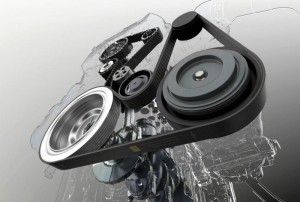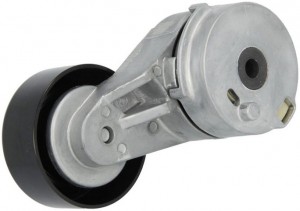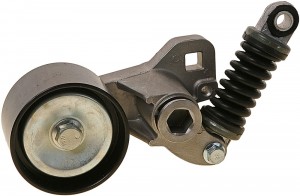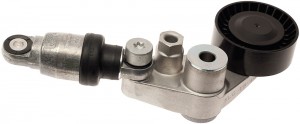
In any modern engine there are mounted units, which are driven by a belt. For normal operation of the drive, an additional unit is introduced into it - the drive belt tensioner. Read all about this unit, its design, types and operation, as well as the right choice and replacement in the article.
What is a drive belt tensioner?
Drive belt tensioner (tension roller or drive belt tensioner) - a unit of the drive system for mounted units of an internal combustion engine; a roller with a spring or other mechanism that provides the necessary degree of tension of the drive belt.
The quality of the drive of mounted units - a generator, a water pump, a power steering pump (if any), an air conditioner compressor - largely depends on the operation of the power unit and the ability to operate the entire vehicle. A necessary condition for the normal operation of the drive of mounted units is the correct tension of the belt used in the drive - with a weak tension, the belt will slip along the pulleys, which will cause increased wear of parts and a decrease in the efficiency of the units; Excessive tension also increases the wear rate of the drive parts and causes unacceptable loads. In modern motors, the required degree of tension of the drive belt is provided by an auxiliary unit - a tension roller or simply a tensioner.
The drive belt tensioner is critical for the normal functioning of the power unit, so this part must be changed in case of any malfunction. But before buying a new roller, you need to understand its existing types, design and principle of operation.
Types and design of drive belt tensioners
Any drive belt tensioner consists of two parts: a tensioning device that creates the necessary force, and a roller that transmits this force to the belt. There are also devices that use a tensioner-damper - they provide not only the necessary belt tension, but also reduce the intensity of wear of the belt and pulleys of the units in transient modes of operation of the power unit.
The tensioner can have one or two rollers, these parts are made in the form of a metal or plastic wheel with a smooth working surface on which the belt rolls. The roller is mounted on a tensioning device or on a special bracket through a rolling bearing (ball or roller, usually single-row, but there are devices with double-row bearings). As a rule, the working surface of the roller is smooth, but there are options with collars or special protrusions that prevent the belt from slipping while the engine is running.
The rollers are mounted directly on tensioning devices or on intermediate parts in the form of brackets of various designs. Tensioning devices can be divided into two groups according to the method of adjusting the tension force of the drive belt:
● With manual adjustment of the degree of tension;
● With automatic adjustment of the degree of tension.
The first group includes the simplest mechanisms in design, which use eccentric and slide tensioning devices. The eccentric tensioner is made in the form of a roller with an offset axis, when rotated around which the roller is brought closer or farther from the belt, which provides a change in tension force. The slide tensioner is made in the form of a roller mounted on a movable slider that can move along the groove of the guide (bracket). The movement of the roller along the guide and its fixation in the selected position is carried out by the screw, the guide itself is installed perpendicular to the belt, therefore, when the roller moves along it, the tension force changes.
Devices with manual adjustment of belt tension on modern engines are rarely used, since they have a significant drawback - the need to change the interference during the first installation of this part and as the belt stretches. Such tensioners cannot provide the necessary degree of belt tension during the entire service life, and manual adjustment does not always save the situation - all this leads to intensive wear of drive parts.
Therefore, modern motors use tensioning devices with automatic adjustment. Such tensioners are divided into three groups according to the design and principle of operation:
● Based on torsion springs;
● Based on compression springs;
● With dampers.



The most widely used devices are based on torsion springs - they are quite compact and effectively perform their functions. The basis of the device is a large-diameter coiled spring placed in a cylindrical cup. The spring with one extreme coil is fixed in the glass, and the opposite coil rests on the bracket with a roller, the glass and the bracket can be rotated at a certain angle limited by the stops. In the manufacture of the device, the glass and bracket are rotated at a certain angle and fixed in this position by a safety device (check). When mounting the tensioner on the engine, the check is removed and the bracket is deflected under the action of the spring - as a result, the roller rests against the belt, providing the necessary degree of its interference. In the future, the spring will maintain the set tension, making adjustment unnecessary.
Devices based on compression springs are used less frequently, as they take up more space and are less efficient. The basis of the tensioning device is a bracket with a roller, which has a swivel connection with a twisted cylindrical spring. The second end of the spring is mounted on the engine - this ensures the necessary belt interference. As in the previous case, the tension force of the spring is set at the factory, so after installing the device on the engine, a check or fuse of a different design is removed.
The development of tensioners with a compression spring was a device with dampers. The tensioner has a design similar to that described above, but the spring is replaced by a damper, which is mounted to the bracket with the roller and the motor with the help of eyelets. The damper consists of a compact hydraulic shock absorber and a coiled spring, and the shock absorber can be located both inside the spring and act as a support for the last coil of the spring. A damper of this design provides the necessary belt interference, while smoothing out the vibration of the belt when starting the engine and in transient modes. The presence of a damper repeatedly extends the life of the drive of mounted units and ensures its more efficient functioning.
In conclusion, it should be noted that the described design has tensioners with both one and two rollers. In this case, devices with two rollers can have one common tensioning device, or separate devices for each of the rollers. There are other constructive solutions, but they have received little distribution, so we will not consider them here.
Issues of selection, replacement and adjustment of the drive belt tensioner
The tension roller of the drive belt, like the belt itself, has a limited resource, the development of which must be replaced. Different types of tensioners have a different resource - some of them (the simplest eccentric) must be changed regularly and together with the replacement of the belt, and devices based on springs and with dampers can serve almost during the entire operation of the power unit. The timing and procedure for replacing tensioning devices are indicated by the manufacturer of a particular power unit - these recommendations should be strictly adhered to, otherwise various negative consequences for the power unit are possible, including its jamming (due to overheating due to stopping the pump).
Only those types and models of tensioners that are recommended by the manufacturer of the power unit should be taken for replacement, especially for cars under warranty. "Non-native" devices may not coincide in characteristics with "native" ones, so their installation leads to a change in the tension force of the belt and a deterioration in the operating conditions of the drive of mounted units. Therefore, such a replacement should be resorted to only in extreme cases.
When buying a tensioning device, you should purchase all the necessary components for it (if they are not included) - fasteners, brackets, springs, etc. In some cases, you can take not whole tensioners, but repair kits - only rollers with installed bearings, brackets, dampers assembled with springs, etc.
Replacement of the drive belt tensioner should be carried out in accordance with the instructions for repair and maintenance of the vehicle. This work can be performed both with the belt installed and with the belt removed - it all depends on the design of the drive and the location of the tensioning device. Regardless of this, the installation of spring tensioners is always carried out in the same way: the device and the belt are first installed in their place, and then the check is removed - this leads to the release of the spring and the tension of the belt. If for any reason the installation of such a tensioner is performed incorrectly, then it will be difficult to re-install it.
If the tensioning device is correctly selected and installed on the engine, the drive of the units will function normally, ensuring the confident operation of the entire power unit.
Post time: Jul-13-2023
